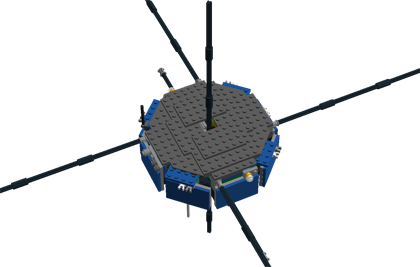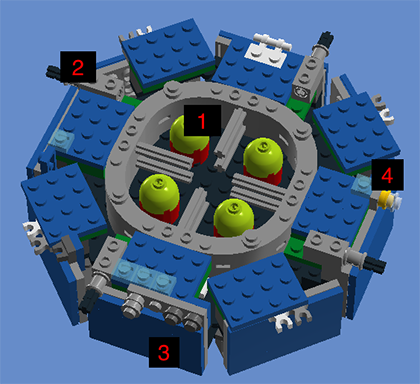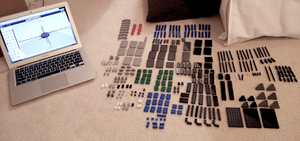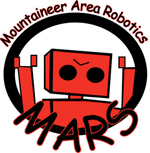Youth engineering design challenges are sweeping formal and informal education worldwide. Just one of these events, the First Lego© League (FLL) involved over 200,000 9-16 year olds from over 55 countries who participated in the 2011 competition alone. MMS capitalized on this inertia by challenging the award winning Morgantown Area Robotics (MARS) team to design and build a ‘low’ and a ‘high’ resolution LEGO© model of the MMS spacecraft. Over a dozen middle school, high school and college students from the MARS team accepted the challenge and went to work on a design under the guidance of research physicists, robotic and engineering experts, and NASA education specialists.
Lego Representation
Enjoy this model of the MMS spacecraft built entirely out of LEGO© bricks! Use the instructions below to:
 |
 |
Step 1:
Download and install the free LEGO© Digital Designer (LDD) program. This FREE program lets you build with LEGO© bricks on your computer. It works on both PC and Mac: http://ldd.lego.com/.
Step 2:
Download the MMS_Body_And_Antenna.lxf.zip and MMS_Top.lxf.zip files. Double click the file to open it within the ‘LEGO© Digital Designer’ program.
+ Download MMS_Body_And_Antenna.lxf.zip | ZIP | 19MB
+ Download MMS_Top.lxf.zip | ZIP | 7KB
+ Download Printable Directions | PDF | 423KB | 4 Pages
Step 3:
View the ‘Building Guide’ by pressing the “building guide model” button in the top right corner of the LDD window (or just press F7).
Step 4 (optional):
Build the body and antenna set of directions first, then the top of the MMS, this is so that you may explore the inside of the satellite. If you desire to attach the top align it with the bottom and click together. To investigate the complete satellite in LEGO© Digital Designer download MMS_Low_Res_Model.lxf.zip
+ Download MMS_Low_Res_Model.lxf.zip | ZIP | 25KB
Step 5 (optional):
Generate a Building Guide by clicking on the ‘Tool Box’ button in the upper right corner of the LDD window (or press Ctrl+H)
 Step 1: Download the Parts List
Step 1: Download the Parts List
+ Download | PDF | 129KB | 2 Pages
+ Download | XLSX (Excel) | 17KB
Step 2: Acquiring Parts
Complete Kits:
Kits containing all of the parts necessary to build your own model of the MMS spacecraft can be ordered through the MARS team at a much reduced rate. (For more information including pricing and approximate delivery times, contact Earl Scime at: earl.scime@gmail.com.
Individual Parts:
Visit the ‘LEGO© Pick a Brick’ website. In the ‘Advanced Search’ box found on the left hand side of the ‘Pick a Brick’ web page, enter each of the ‘LEGO© element ID’ numbers found on the ‘MMS LEGO© Brick List’. After each entry make sure to click the orange ‘Add to Bag’ button. For your convenience we have highlighted (in red) the parts that can be harder to find. If having difficulty finding a part, we recommend that you search for the part by using the ‘description’ as opposed to the part number.
Step 3:
Generate a ‘step by step’ set of instructions for model by following the steps provided in, ‘How to View the ‘3-Dimentional’ Model’
NOTE: From time to time the color and/or ID number for a LEGO© brick will change. This can be a challenge when attempting to order specific bricks to construct the MMS model. To help with this issue, we will update the MMS LEGO© Parts List with the parts that have changed or have new ID numbers. However, if you can't locate a specific brick in our most current list, simply do a quick search for a comparable part by name and/or dimension in the ‘Brick Name’ search box under the ‘Advanced Search’ section of the on the Pick a Brick website.
 The MARS program is committed to advancing STEM education in Appalachia by mentoring 5th grade-undergraduate youth in FIRST (For Inspiration and Recognition of Science and Technology) robotics programs. They currently works with over twenty FIRST LEGO© League teams in north-central West Virginia and operates a high-school program that includes youth from four WV counties. Thirty-two high school students participate in MARS, nearly half of them were previously members of FLL teams. Working with the middle and high school students are over 20 adult volunteer mentors including MARS alumni that are now pursing STEM degrees in higher education.
The MARS program is committed to advancing STEM education in Appalachia by mentoring 5th grade-undergraduate youth in FIRST (For Inspiration and Recognition of Science and Technology) robotics programs. They currently works with over twenty FIRST LEGO© League teams in north-central West Virginia and operates a high-school program that includes youth from four WV counties. Thirty-two high school students participate in MARS, nearly half of them were previously members of FLL teams. Working with the middle and high school students are over 20 adult volunteer mentors including MARS alumni that are now pursing STEM degrees in higher education.
Learn more about the award winning MARS team at: http://marsfirst.org
Kits containing all of the parts necessary to build your own model of the MMS spacecraft can be ordered through the MARS team. For more information including pricing and approximate delivery times, contact Earl Scime at: earl.scime@gmail.com.
Supporting Activities:
Activities developed for this project will specifically emphasize the connection between engineering and mathematics. K-12 educators and students will be able to engage in STEM activities that highlight the importance of both the MMS mission and the relevance of the study of Earth’s magnetosphere. All of the activities will be hosted on this website with additional links to the growing gallery of images of MMS instruments and spacecraft construction.
Workshop Templates:
MMS will work with the NASA IV&V Educator Resource Center (ERC) to share the initial MMS Lego designs and supporting activities with over 100 educators in workshops conducted across the state of West Virginia. Participating teachers will learn how to use the activities and related Space Math problems to impact up to 1,000 K-12 students in West Virginia alone! Workshop templates will be shared on this website to assist those wishing to conduct MMS workshops of their own.